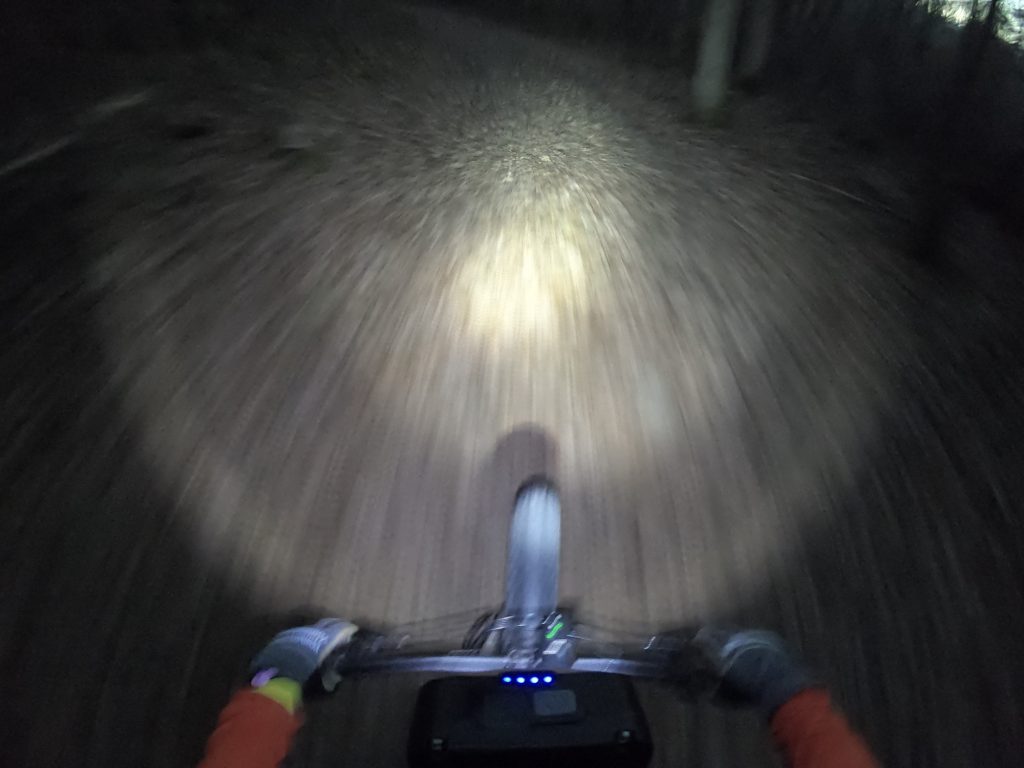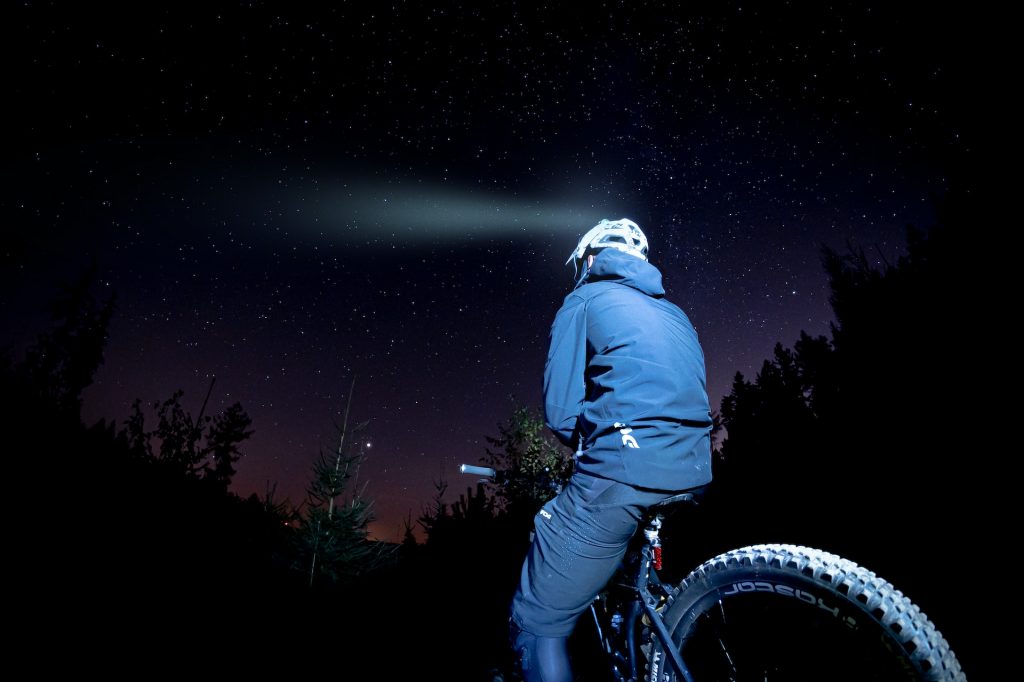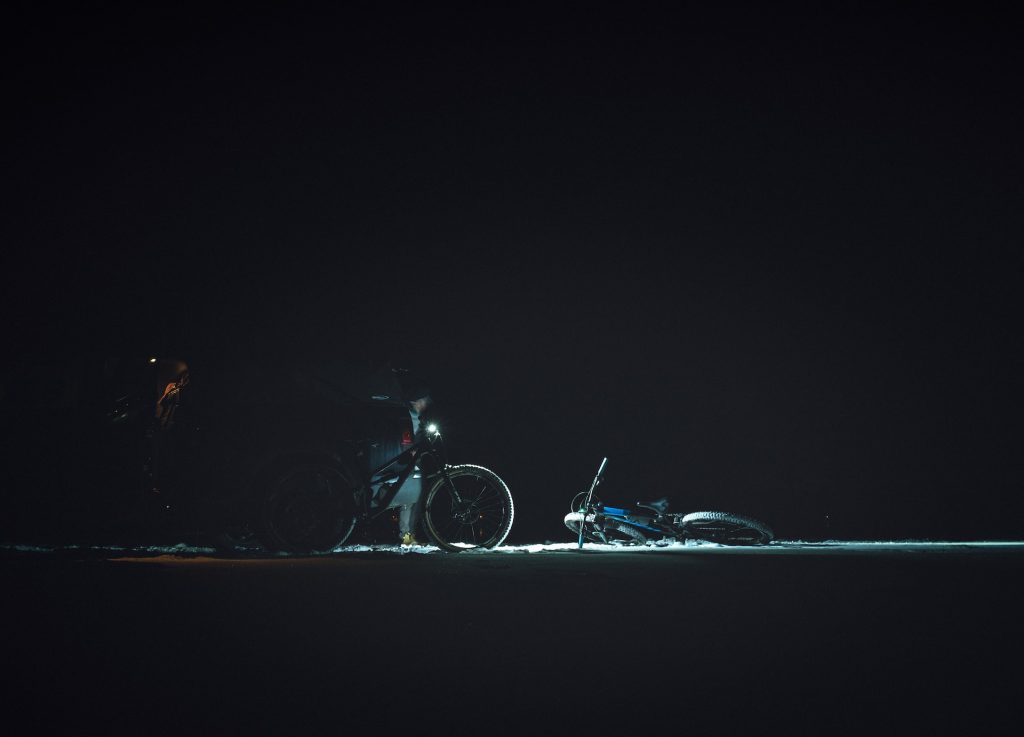The days are getting shorter as fall progresses toward winter, but that doesn’t mean you need to hang up your mountain bike and relegate yourself to the trainer just yet. Night riding is an awesome way to extend your mountain bike season, add a new challenge, and breathe new life into well-traveled trails.
Below are seven tips to make the most of mountain biking after the sun sets.
Seven Tips for Mountain Biking at Night
1. Get the Right Bike Lights
Today’s mountain bike lights are bright, sleek, and powerful—making the days of jury-rigged setups, annoying (and easily tangled) cords, and toting around massive battery packs a distant memory. It’s ideal to use two lights when mountain biking at night: one mounted on your handlebars and another mounted on your helmet. This configuration delivers light both in the direction your bike is pointed as well as in the direction you’re looking. It also adds redundancy, in case one of your lights dies.
It’s generally recommended that you mount a more powerful light on your handlebars (mine is 3,500 lumens) and a smaller, less strong light on your helmet (I use a 350-lumen light). If you’re shopping for lights, I recommend getting the brightest one possible; you can always operate your lights at a lower setting, but you can’t make a less powerful light brighter.
Pro tip: Invest in a taillight. They’re light, relatively inexpensive, and will help keep you visible (both on the road to vehicles and off the road to other riders). Just remember to avoid using it in its flash mode when on the trail, as a blinking rear light is hard on the eyes of riders behind you.
2. Manage Your Bike Lights
Paying attention to how you operate your bike lights can maximize both your battery and trail time. Running your lights on their brightest setting burns precious battery life. Consequently, turn your lights down when you don’t need full power—like grinding up a long climbing or soft pedaling on doubletrack—and turn them up for speedy descents or navigating technical sections like rock gardens.
Also, get in the habit of turning your lights off when stopped. This will both conserve battery life and keep you from inadvertently blinding anyone you’re riding with.
3. Ride Trails You Know
Like most riders, I love to explore on my mountain bike. However, when riding at night I prefer to keep it simple and stick to trails I know well—saving the adventure of unknown singletrack and techy trails for daylight. This is especially true for those just getting started riding at night.
It’s surprising how different everything looks in the dark, which can make it easy to get turned around, even on your local loop. It’s also worth noting that you have a limited view of your surroundings when night riding, which has a way of making even tame trails feel treacherous.
4. Stay Within Your Limits
Mountain biking at night can make it easier to get lost and increases the challenge of trails. It can also obscure obstacles, like an unknown drop, unseen roots, or rock poised for a pedal strike at the edge of the trail. In general, it’s a good plan to stay within your ability level.
5. Get a Bike Buddy
The trails are a lot quieter after dark, which means everything from an injury to a mechanical to your lights dying can be a serious issue. There’s safety in numbers and a riding partner is a great precaution in the event something goes sideways…like you or your bike.
A nighttime bike buddy also makes riding more fun and is a great way to ensure you hit the trails. Trust me, it’s hard to get motivated to mountain bike when it’s dark and cold before you’ve even made it to the trailhead.
6. Use a Tracker App
Use a tracker app or take advantage of the real-time location-sharing features found on popular apps like Strava, Ride with GPS, and Garmin Connect. Whether you crash hard or simply get separated from your riding buddies, a tracker app can make getting assistance significantly faster and easier.
7. Make Your Mountain Bike Heard
As mentioned above, the trails are a lot quieter at night—which means there’s a lot more wildlife around than during the day. To me, there’s nothing more terrifying than rounding a corner and meeting a set of yellow glowing eyes, no matter if they belong to a coyote, porcupine, or deer. Because of this, I mount a bear bell on my handlebars to announce my presence to the creatures of the forest.
Other Tips for Mountain Biking at Night
- Riding after dark is one of the few times it’s cool to be like Corey Hart and wear sunglasses at night—so long as they have clear lenses, which protect your eyes from branches, overgrowth, and debris kicked up by bike tires.
- The temperature can drop pretty fast at night, so pack an extra layer and consider carrying warm gloves and a lightweight winter hat that fits under your helmet.
- Don’t ride too close to the biker in front of you, as your light can create disorienting shadows for them.
- Getting separated sucks. Make sure to wait for all the riders in your group at trail intersections.
- The chances of a crash are higher at night, so make sure to pack a small first-aid kit and know how to treat common trail injuries.
- You burn more calories when biking in the cold, so also make sure to pack a snack.

Final Thoughts About Mountain Biking at Night
Mountain biking after dark requires a little bit more work, but with the proper preparation, night is the right time for a ride. Plus, it’s way better than pedaling the trainer—which you can’t jump or wheelie—or riding the couch. Just remember to keep it simple and stay safe.
Luke Foley
Luke Foley is passionate about discovering and sharing hidden local treasures and has long been a New England adventure enthusiast. After all, there are only a few places where you can skin for fresh tracks in the morning and have a sunset surf session on the same day.






